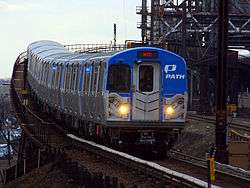Downtown Hudson Tubes
 1909 illustration of flying junction of Uptown Hudson Tubes in Jersey City which connect to Downtown tubes to the south | |
| Overview | |
|---|---|
| Location | Hudson River |
| Coordinates | 40°42′54″N 74°01′28″W / 40.7151°N 74.0244°W |
| System | PATH |
| Start | World Trade Center |
| End | Exchange Place |
| Operation | |
| Constructed | 1906-1909 |
| Opened | July 19, 1909 |
| Traffic | Railroad |
| Character | Rapid transit |
| Technical | |
| Design engineer | Charles M. Jacobs |
| Length | 5,650 ft (1,722 m)[1] |
| Track gauge | 4 ft 8 1⁄2 in (1,435 mm) standard gauge |
| Electrified | 600 V DC third rail |
| Tunnel clearance | 15.25 ft (4.65 m)[1] |
| Depth of tunnel below water level |
97 ft (29.6 m) below sea level[1] |
| Depth of shipping channel above | (?) |
 Downtown Hudson Tubes | |
The Downtown Hudson Tubes are a pair of tunnels that carry PATH trains under the Hudson River between New York City and Jersey City in the United States. In lower Manhattan the trains travel to and from the World Trade Center station. In Jersey City the trains stop at the Exchange Place station. The tunnels were the second non-waterborne connection between Manhattan and New Jersey and were completed shortly after the uptown Hudson tubes.
The original tubes were built intermittently between 1874 and 1906.[1] An engineer who worked on the project was Ernest William Moir, who was originally resident engineer, but became contractor’s agent (for S. Pearson & Son) in January 1890, working there until British engineering efforts were suspended in 1891.[2] Regular passenger service began on February 26, 1908. Construction of the downtown tubes began in 1906 and was completed in 1909.[3] They began service at the Hudson & Manhattan Railroad's Hudson Terminal in lower Manhattan starting on July 19, 1909.[4]
When the original World Trade Center was constructed in the 1960s, the Hudson Tubes remained in service as elevated tunnels until 1970, when a new PATH station was built.[5] The downtown and uptown tubes were declared National Historic Civil Engineering Landmarks in 1978 by the American Society of Civil Engineers.[6] Some remnants of the tunnels under the original World Trade Center were removed during 2007 and 2008.[7]
See also
References
- 1 2 3 4 Fitzherbert, Anthony (June 1964). ""The Public Be Pleased": William G. McAdoo and the Hudson Tubes". Electric Railroaders Association, nycsubway.org. Retrieved 2010-01-18.
- ↑ Hudson River Tunnel - Engineering Timelines
- ↑ Cudahy, Brian J. (2002). Rails Under the Mighty Hudson (2nd ed.). New York: Fordham University Press. p. 18. ISBN 0-8232-2190-3. OCLC 48376141.
- ↑ Port Authority of New York and New Jersey. "PATH:History". Retrieved 2010-01-19.
- ↑ Carroll, Maurice (December 30, 1968). "A Section of the Hudson Tubes is Turned into Elevated Tunnel". The New York Times.
- ↑ "History and Heritage of Civil Engineering: Hudson and Manhattan Railroad Tunnel". American Society of Civil Engineers. Retrieved 2009-03-13.
- ↑ Dunlap, David W. (October 26, 2008). "Another Ghost From Ground Zero's Past Fades Away". The New York Times.
Further reading
- Burr, S.D.V. (1885). Tunneling Under The Hudson River: Being a description of the obstacles encountered, the experience gained, the success achieved, and the plans finally adopted for rapid and economical prosecution of the work. New York: John Wiley and Sons. Retrieved 2010-01-18.
